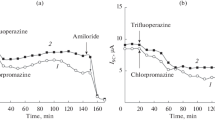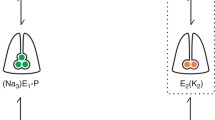Summary
Experimental conditions are described in which transient and positive current responses across isolated frog skin epithelia can be elicited by sudden addition of Na and Li ions (2–40 mM) in the outer bathing solution. Subsequent return to outer Na (or Li) free conditions produce similar transient current changes but in the opposite direction. Analysis of the curve responses shows that the transient component of each curve is best described by a single, fast exponential term equation in case of Na addition to preparation unpoisonned with ouabain. In contrast, an equation including two exponential terms (a fast and a slow one) is required to fit the curve responses observed across ouabain treated epithelia of if Li is added outside. The transient responses were not significantly altered by substituying Cl for SO4 2− anions. They were completely prevented by Amiloride (5 · 10−5 M), increased by oxytocin (20 mU/ml) and markedly dependent upon the outer Na concentration. Interpreted in term of compartmental analysis, these observations suggest that a) the frog skin epithelium contains 2 separated but communicating compartments having different degrees of accessibility from outside; b) only that compartment filling at a fast rate (0.5 min) is involved in the transepithelial Na transport; c) the other one, filling at a rate of 4 to 7 min, is resplenished only under conditions where the basal pump system has a reduced activity. Tentative localization of these compartment is proposed.
Similar content being viewed by others
References
Aceves, J., Erlij, D.: Sodium transport across the isolated epithelium of the frog skin. J. Physiol. (Lond.)212, 195–210 (1971)
Biber, T. U. L.: Effect of change in transepithelial transport on the uptake of sodium across the outer surface of the frog skin. J. gen. Physiol.58, 131–144 (1971)
Biber, T. U. L., Curran, P. F.: Direct measurement of uptake of sodium at the outer surface of the frog skin. J. gen. Physiol.56, 83–99 (1970)
Bricker, N. S., Biber, T. U. L., Ussing, H. H.: Exposure of the isolated frog skin to high potassium concentration at the internal surface. I. Bioelectric phenomena and sodium transport. J. clin. Invest.42, 88–94 (1963)
Cereiido, M., Rotunno, C. A.: Transport and distribution of sodium across frog skin. J. Physiol. (Lond.)190, 481–497 (1967)
Cereijido, M., Rotunno, C. A.: The effect of antidiuretic hormone on Na movement across frog skin. J. Physiol. (Lond.)213, 119–133 (1971)
Erlij, D.: Salt transport across isolated frog skin. Phil. Trans. roy. Soc. B262, 153–161 (1971)
Erlij, D., Smith, M. W.: Sodium uptake by frog skin and its modification by inhibitors of transepithelial sodium transport. J. Physiol. (Lond.)228, 221–239 (1973)
Farquar, M. G., Palade, G. E.: Functional organization of amphibian skin. Proc. nat. Acad. Sci. (Wash.)51, 569–577 (1964)
Herrera, F. C., Egea, R., Herrera, A. M.: Movement of Li across toad urinary bladder. Amer. J. Physiol.220, 1501–1508 (1971)
Hansen, H. H., Zerahn, K.: Concentration of lithium, sodium and potassium in epithelial cells of the isolated frog skin during active transport of lithium. Acta physiol. scand.60, 189–196 (1964)
Koefoed-Johnsen, V., Ussing, H. H.: The nature of the frog skin potential. Acta physiol. scand.42, 298–308 (1958)
Leblanc, G.: The mechanism of lithium accumulation in the isolated frog skin epithelium. Pflügers Arch.337, 1–18 (1972)
MacRobbie, E. A. C., Ussing, H. H.: Osmotic behaviour of the epithelial cells of the frog skin. Acta physiol. scand.53, 348–365 (1961)
Morel, F., Leblanc, G.: Kinetics of sodium and lithium accumulation in isolated frog skin epithelium. In: Transport mechanisms in epithelia. A. Benzon Symposium V. Eds. H. H. Ussing and N. A. Thorn, pp. 28–37. Copenhagen: Munksgaard 1973
Moreno, J. H., Reisin, I. L., Rodriguez-Boulan, E., Rotunno, C. A., Cereijido, M.: Barriers to sodium movement across frog skin. J. Membrane Biol. hf. 99–115 (1973)
Rajerison, R. M., Montegut, M., Jard, S., Morel, F.: The isolated frog skin epithelium: permeability characteristics and responsivness to oxytocin, cyclic AMP and theophylline. Pflügers Arch.332, 302–312 (1972)
Rawlins, F., Mateu, L., Fragachan, F., Whittermbury, G.: Isolated toad skin epithelium transport characteristics. Pflügers Arch.316, 64–80 (1971)
Smith, P. G.: The low-frequency electrical impedance of the isolated frog skin. Acta physiol. scand.81, 355–366 (1971)
Solomon, A. K.: Compatmental methods of kinetic analysis; in mineral metabolism. Eds. C. L. Comar and F. Bronner, pp. 120–167. New York: Academic Press 1960
Ussing, H. H.: Structure and function of epithelia. In: Electrophysiology of epithelial cells. Eds. G. Giebisch, pp. 3–16. Stuttgart: F. K. Schattauer 1971
Ussing, H. H., Biber, T. U. L., Bricker, N. S.: Exposure of the isolated frog skin to high potassium concentration at the internal surface. II. Changes in epithelial cell volume, resistance and response to antidiuretic hormone. J. gen. Physiol.48, 425–433 (1965)
Ussing, H. H., Erlij, D., Lassen, U.: Transport pathways in biological membranes. Ann. Rev. Physiol.36, 17–49 (1974)
Ussing, H. H., Windhager, E. E.: Nature of shunt path and active transport path through frog skin epithelium. Acta physiol. scand.61, 484–504 (1964)
Vôute, C. L., Ussing, H. H.: Some morphological aspects of active sodium transport. The epithelium of the frog skin. J. Cell. Biol.36, 625–638 (1968)
Vôute, C. L., Ussing, H. H.: Quantitative relation between hydrostatic pressure gradient, extracellular volume and active transport in the epithelium of the frog skin. Exp. Cell Res.62, 375–383 (1970)
Zerahn, K.: Studies on the active transport of lithium in the isolated frog skin. Acta physiol. scand.33, 347–358 (1955)
Zerahn, K.: Nature and localization of the sodium pool during active transport in the isolated frog skin. Acta Physiol. scand.77, 272–281 (1969)
Author information
Authors and Affiliations
Rights and permissions
About this article
Cite this article
Morel, F., Leblanc, G. Transient current changes and Na compartimentalization in frog skin epithelium. Pflugers Arch. 358, 135–157 (1975). https://doi.org/10.1007/BF00583924
Received:
Issue Date:
DOI: https://doi.org/10.1007/BF00583924




